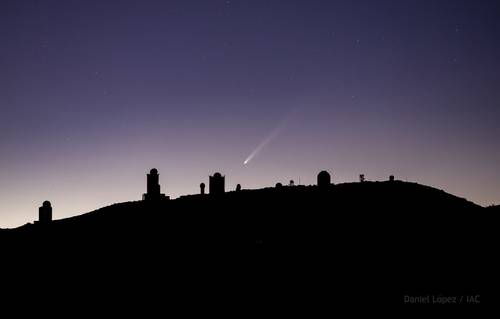Madrid. The C/2023 A3 Tsuchinshan-Atlas, known as the comet of the century
could be easily seen with the naked eye crossing the night sky during these days. The comet will pass close to the Sun without disintegrating and will reach its closest point to Earth today.
The best time to observe it will be at sunset around 8:00 p.m. To do this, you have to look to the west, reported eltiempo.es.
This celestial body, composed of ice and dust, approaches Earth offering a spectacle that will not be repeated for thousands of years. As of today, the comet is visible to the naked eye in the northern hemisphere, showing a luminous tail that extends across the sky.
Discovered in January 2023 by the Tsuchinshan Observatory telescopes in China and confirmed by the Atlas project in South Africa, the star has been dubbed the comet of the century
due to its exceptional brilliance and the rarity of its career. It is estimated that their last visit to the inner solar system occurred about 80 thousand years ago, at a time when Neanderthals inhabited the Earth.
The celestial body has surprised astronomers and amateurs with its intense luminosity. According to Javier Licandro, astronomer at the Institute of Astrophysics of the Canary Islands (IAC), the comet is currently much brighter than Mercury
one of the most luminous planets in the night sky.
This characteristic is measured by stellar magnitude, a scale that determines the brightness of celestial objects. Images captured by the SOHO (Solar and Heliospheric Observatory) satellite show that the comet has developed an impressive tail.
The tail of the comet of the century reaches a length equivalent to the diameter of 42 full moons, a spectacle that few astronomical phenomena can match.
To fully enjoy the star, experts recommend observing it from places with little light pollution and with a clear western horizon.
The best time to see it is just after sunset, around 8:00 p.m. With each passing day, the comet will be higher in the sky after nightfall, making it easier to observe. It is advisable to use magnifying binoculars to better appreciate the details of its nucleus and its extensive tail.
However, due to its intense brightness, it is also possible to see it with the naked eye. In Spain, the Canary Islands offer ideal conditions for observation, thanks to their clear skies and low levels of light pollution.
It has been compared to historical comets such as Hale-Bopp and Hyakutake, which in the 1990s left a deep impression on those who observed them. The first, in particular, was so bright that it could be seen even during the day with the help of telescopes.
Period of intense solar activity
This astronomical event coincides with a period of intense solar activity, which has allowed the appearance of northern lights at unusually low latitudes, including regions of the Iberian Peninsula.
Although it is unlikely to see the comet and the auroras simultaneously, due to differences in times and directions in the sky, the possibility of witnessing both phenomena on the same night has generated great excitement.
The Sun is in a particularly active stage of its 11-year cycle, increasing the frequency and intensity of auroras. Observing them from more southern latitudes is a rare event, and current conditions make it a real possibility, adding even more attraction to nightly viewing.
Comets are celestial bodies made up of ice, dust and small rock particles. When they approach the Sun, the heat causes the frozen materials to sublimate, going from a solid to a gaseous state.
This generates a diffuse atmosphere around the core called a coma, and a tail that always points away from the Sun due to the solar wind. The Tsuchinshan-Atlas comes from the Oort cloud, a vast and distant reservoir of icy bodies that surrounds the solar system.
This comet is estimated to have a non-periodic orbit, meaning it may never return. After its close pass by Earth, it will continue its journey towards the far reaches of the solar system, possibly influenced by the gravity of other planets or stars.
For those who want to capture the moment, October 19 and 20 could be ideal for taking photographs, as the full Moon will have passed and the lunar glow will not interfere with the observation of the comet, making it an exceptional opportunity for astronomers. amateurs and night sky photographers.
After its spectacular appearance, the comet will continue on its path, moving further and further away from Earth. Orbital models suggest it won’t come close to our planet again for hundreds of thousands of years, if ever. This is literally a once in a lifetime opportunity to witness this phenomenon.
